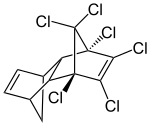Dirty dozen
As Dirty Dozen ( English dirty dozen ) known twelve toxins (u. A. Pesticides , industrial chemicals and by-products of combustion processes ) through which were POP -Convention or the Stockholm Convention on 22. May 2001 banned worldwide. The UN agreement entered into force when France was signed on May 17, 2004. All twelve toxins are organic chlorine compounds and are strongly suspected of being carcinogenic , mutagenic and teratogenic . Their danger results primarily from possible bioaccumulation (accumulation in tissue), persistence (longevity), high toxicity (poisonousness) and the possibility of long-distance transport (e.g. in the food chain or through other mechanisms). Some of the substances are also known as endocrine disruptors . From 2009 further substances have been included in the Stockholm Convention.
The twelve substances or substance groups concerned
| structure | Surname | description |
|---|---|---|
| Aldrin | insecticide | |
|
|
Chlordane | insecticide |
| Dieldrin | insecticide | |
| Dichlorodiphenyltrichloroethane (DDT) | insecticide | |
| Endrin | insecticide | |
|
|
Heptachlor | insecticide |
| Hexachlorobenzene (HCB) | Fungicide , dry dressing agent | |
| Mirex | insecticide | |
| Polychlorinated biphenyls (PCB) | Industrial chemicals | |
|
Polychlorinated Dibenzodioxins (PCDD, "Dioxins") |
By-products of combustion processes | |
|
Polychlorinated dibenzofurans (PCDF, "furans") |
By-products of combustion processes | |
|
|
Toxaphene ("camphechlor") | insecticide |
Web links
- The 12 initial POPs under the Stockholm Convention on the Convention website











